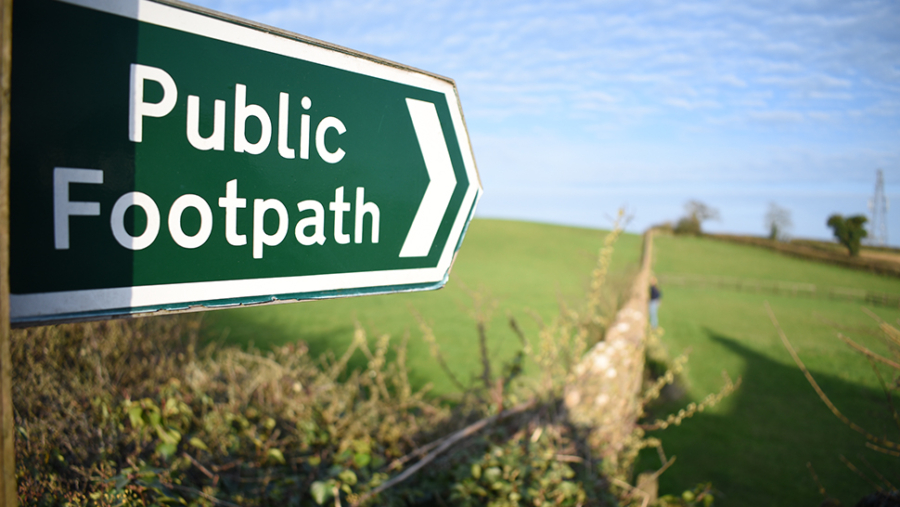
Landowner applications to divert public rights of way – What are the legal tests?
11th May 2020

Landowners affected by a public right of way crossing their land can apply to the local highway authority for its diversion under section 119 of the Highways Act 1980. But what are the legal tests which landowners will need to meet? The High Court in The Open Spaces Society v Secretary of State for Environment, Food And Rural Affairs [2020] EWHC 1085 (Admin) has recently provided some useful guidance.
How are S119 applications made and decided?
There are three main steps for the determination of applications to divert a public right of way under section 119. These are:
Step 1 – Submit your application
You will need to check with the relevant council as to whether they have any prescribed S119 application forms and required documents and plans. You will likely be required to agree to pay all costs of the council and indemnify the council against any claims for compensation. Key issues to consider as part of any S119 application are:
- Consider the route of the proposed diversion and in particular whether or not it will be substantially less convenient to the public. If you propose to alter a termination point of the route then the new termination point must be substantially as convenient to the public;
- Consider pre-application consultation with residents and relevant user groups like the Ramblers Association and Open Spaces Society. This can be beneficial, reduce points of contention and overall save time. Many councils have a priority policy for determination of applications, and pre-application consultation can expedite your application but always remember that S119 applications can take several years from start to finish;
- Set out why the diversion is beneficial to you and the land (and in any other ways) such as to reasonably justify its need. Issues like privacy, security and noise of a route that passes through a private garden or pass a house window are common examples;
- Check landownership affected by the proposed diversion. If the diversion will affect neighbouring land then such neighbours may be entitled to compensation (for which you will be required to indemnify the council); and
- Consider what works may be required to create the new route as they will be at your cost.
Step 2 – Decision by the Council
Once the application has been submitted, the council will determine whether to make a public path diversion order. This is a low threshold test. The council at this stage will only consider (i) whether it is expedient that the line of a route should be diverted in the interests of the owner, lessee or occupier of land crossed by it (ie. a balancing judgement on the reasons why you are applying) and (ii) whether termination points of the route are altered and if so whether the new termination points are onto a highway and substantially as convenient to the public.
If the council make a public path diversion order then they will carry out formal statutory consultation and issue the required notices. Importantly, the order at this stage has no legal effect. There are no rights of appeal at this stage other than judicial review to the High Court.
Stage 3 – Confirmation
The confirmation of a public path creation order will give it legal effect. If there are objections to the made order then the council will refer the decision on whether to confirm the order to the Secretary of State. If there are no objections then the council will decide whether to confirm the order. Section 119(6) sets out the following three legal tests for whether or not to confirm a made order (applicable for both opposed and unopposed cases):
- That the diversion is expedient;
- That the diverted path or way will not be substantially less convenient to the public;
- That the diversion is expedient having regard to its effect on:
- (a) public enjoyment of the path or way;
- (b) other land served by the existing public right of way; and
- (c) any land over which the new public rights of way is created and any land held with it.
The Case Facts
The Open Spaces Society (OSS) case concerned a judicial review of the decision dated 31 October 2019 of an Inspector (Ms K.R. Saward) appointed by the Secretary of State for Environment, Food and Rural Affairs (order ref: ROW/3217703). The Inspector had decided to confirm the Oxfordshire County Council Rollright Footpath No. 7 (Part) Public Path Diversion and Definitive Map and Statement Modification Order 2015 which was made by the Council on 28 May 2015 (NB. Note the 4+ year time period which is not unusual).
In relation to each of the three tests under section 119(6) (ie. Step 3 above) the inspector found:
- Test 1 – diversion was expedient in the owner’s interest – the present owners had bought the property in 2015 and they had particular concerns over their privacy given their high media profile. The Inspector found that there was a considerable impact on their privacy, both in terms of people on FP7 being able to look into certain windows of the property but also looking into the garden, including the terrace and croquet lawn.
- Test 2 – new footpath would not be substantially less convenient to the public – the Inspector found that there would be a negligible impact on convenience from the diversion and that there was consensus at the hearing that the new path would not be “substantially less convenient to the public” than the existing path.
- Test 3 – it was expedient to confirm the Order – The Inspector considered that this was an overarching balancing exercise and found “In this case, there is a relatively minor loss of public enjoyment of the path as a whole which must be weighed against the interests of the owners/occupiers. On balance, I consider that the benefits to the owners and occupiers outweigh the loss of public enjoyment. As such it would be expedient to confirm the Order”.
The OSS challenged the Inspector’s interpretation of Test 3 and in particular whether it was open for her to include considerations outside the matters specifically mentioned in Test 3 of s119(6) (as set out above) such as the benefits of the diversion to the landowner within such balancing exercise.
The Decision
The Court rejected the arguments of the OSS and found that the Inspector was correct in that a broad balance or merit judgement is to be made by the decision-maker under Test 3. The decision-maker is required to consider the expressly stated negative factors in the Test, but such considerations were not an exclusionary list. Benefits of the diversion to landowners and the public were also relevant considerations under the balancing exercise of Test 3. This could include by example other wider possible benefits such as the interests of agriculture, forestry or biodiversity.
Lesson
If the OSS were correct as to the limited scope of the expediency judgement on the overall merits of a S119 Application in Test 3 then that would have greatly tilted the balance of such applications in favour of objecting public users and user groups, and made successful applications much more difficult for landowners. The interpretation of Test 3 by the Court is a sensible decision and highlights how well-reasoned private and/or non-highway benefits can potentially outweigh any negative impacts to public users.










